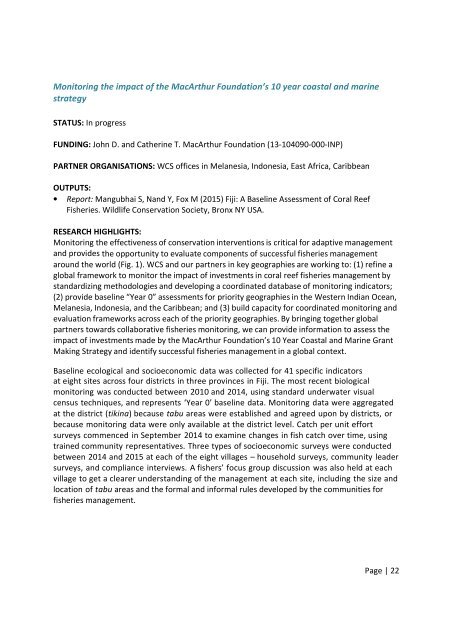FIJI COUNTRY PROGRAM 2015
2015_annual_report_20151214
2015_annual_report_20151214
You also want an ePaper? Increase the reach of your titles
YUMPU automatically turns print PDFs into web optimized ePapers that Google loves.
Monitoring the impact of the MacArthur Foundation’s 10 year coastal and marine<br />
strategy<br />
STATUS: In progress<br />
FUNDING: John D. and Catherine T. MacArthur Foundation (13-104090-000-INP)<br />
PARTNER ORGANISATIONS: WCS offices in Melanesia, Indonesia, East Africa, Caribbean<br />
OUTPUTS:<br />
• Report: Mangubhai S, Nand Y, Fox M (<strong>2015</strong>) Fiji: A Baseline Assessment of Coral Reef<br />
Fisheries. Wildlife Conservation Society, Bronx NY USA.<br />
RESEARCH HIGHLIGHTS:<br />
Monitoring the effectiveness of conservation interventions is critical for adaptive management<br />
and provides the opportunity to evaluate components of successful fisheries management<br />
around the world (Fig. 1). WCS and our partners in key geographies are working to: (1) refine a<br />
global framework to monitor the impact of investments in coral reef fisheries management by<br />
standardizing methodologies and developing a coordinated database of monitoring indicators;<br />
(2) provide baseline “Year 0” assessments for priority geographies in the Western Indian Ocean,<br />
Melanesia, Indonesia, and the Caribbean; and (3) build capacity for coordinated monitoring and<br />
evaluation frameworks across each of the priority geographies. By bringing together global<br />
partners towards collaborative fisheries monitoring, we can provide information to assess the<br />
impact of investments made by the MacArthur Foundation’s 10 Year Coastal and Marine Grant<br />
Making Strategy and identify successful fisheries management in a global context.<br />
Baseline ecological and socioeconomic data was collected for 41 specific indicators<br />
at eight sites across four districts in three provinces in Fiji. The most recent biological<br />
monitoring was conducted between 2010 and 2014, using standard underwater visual<br />
census techniques, and represents ‘Year 0’ baseline data. Monitoring data were aggregated<br />
at the district (tikina) because tabu areas were established and agreed upon by districts, or<br />
because monitoring data were only available at the district level. Catch per unit effort<br />
surveys commenced in September 2014 to examine changes in fish catch over time, using<br />
trained community representatives. Three types of socioeconomic surveys were conducted<br />
between 2014 and <strong>2015</strong> at each of the eight villages – household surveys, community leader<br />
surveys, and compliance interviews. A fishers’ focus group discussion was also held at each<br />
village to get a clearer understanding of the management at each site, including the size and<br />
location of tabu areas and the formal and informal rules developed by the communities for<br />
fisheries management.<br />
Page | 22


